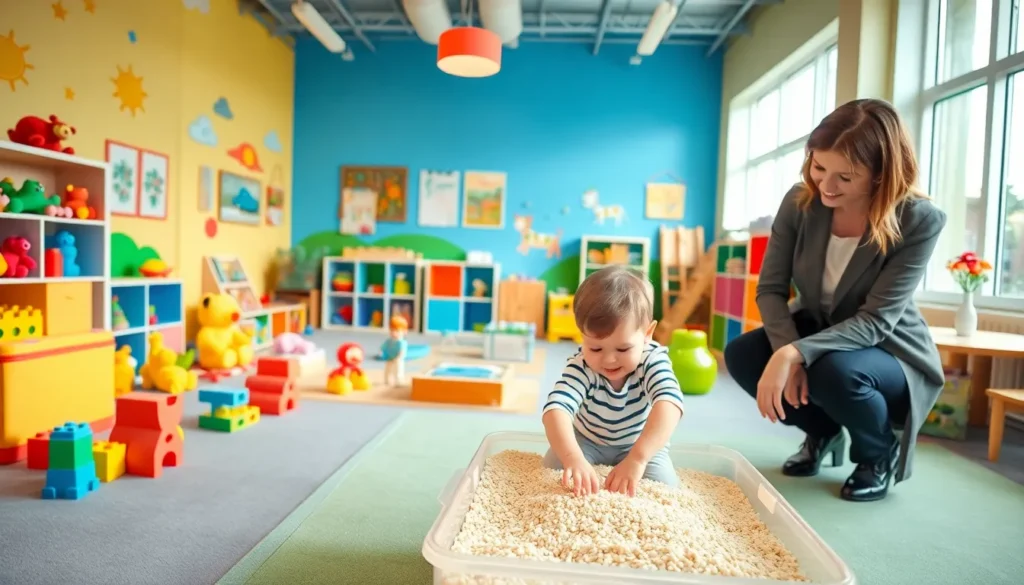Co-parenting can feel like navigating a circus—complete with juggling acts and a few clowns thrown in for good measure. When two parents decide to raise their kids apart, they enter a world where communication is key and patience is tested. But don’t worry, it’s not all tightrope walking and lion taming. With a sprinkle of humor and a dash of teamwork, co-parenting can actually be a rewarding experience.
Table of Contents
ToggleUnderstanding Co-Parenting
Co-parenting involves two parents raising a child together after separation or divorce. This approach requires collaboration, communication, and commitment to the child’s well-being.
Definition of Co-Parenting
Co-parenting refers to the shared responsibilities of raising a child by two parents who do not live together. The arrangement often arises from divorce or separation, with both parents actively participating in decision-making and care. Effective co-parenting emphasizes teamwork, mutual respect, and clear communication. Each parent’s involvement plays a vital role in a child’s emotional and social development. By prioritizing the child’s needs, co-parents can create a nurturing environment, despite their differing living situations.
Importance of Co-Parenting
Co-parenting significantly impacts a child’s life, providing stability and support. Research shows that children benefit from maintaining strong relationships with both parents, which fosters emotional well-being. Effective co-parenting encourages consistent routines, helping children adapt to changes more easily. Parents who co-parent successfully demonstrate positive conflict-resolution skills, which children often emulate. Open communication between parents also models healthy relationships for children. Strong co-parenting practices help minimize parental conflict, creating a safer emotional space for children to thrive.
Strategies for Effective Co-Parenting

Effective co-parenting hinges on strong communication and conflict resolution strategies. Parents can create a more harmonious environment for their children through collaboration and understanding.
Communication Tips
Prioritize open dialogue between parents. Establish regular check-ins to discuss schedules, activities, and any changes. Use clear language to express needs, avoiding jargon that might confuse the other parent. Focus on being respectful during discussions, even when disagreements arise. Listen actively to each other’s concerns, ensuring both parents feel heard. Utilize technology as a tool, employing messaging apps or shared calendars for prompt updates. Recognize the significance of positive language; framing conversations constructively influences how messages are received. Building rapport leads to smoother interactions, fostering an atmosphere of cooperation for the child’s benefit.
Conflict Resolution Techniques
Establish ground rules for conflict resolution to minimize tension. Approach disagreements with a focus on solutions instead of problems. Choose the right time to discuss issues; avoid discussing matters during stressful moments. Consider using a neutral mediator for particularly contentious discussions. Brainstorm solutions together, encouraging collaboration over competition. Emphasize compromise, as flexibility often leads to more agreeable outcomes. When emotions run high, take a break, allowing time to cool down before returning to the discussion. Prioritize the child’s well-being; always frame solutions in the context of what serves their best interests.
Co-Parenting Challenges
Co-parenting involves many challenges that can test patience and cooperation. Emotional struggles often arise for both parents and children.
Emotional Struggles
Navigating the emotional landscape of co-parenting presents significant hurdles. Parents may experience feelings of loss, frustration, or resentment after separation. Children often grapple with confusion and anxiety about their changing family dynamic. Open communication helps address these feelings, fostering emotional connectivity. Prioritizing the child’s emotions creates a supportive atmosphere, allowing them to express their thoughts freely. Parent education programs offer resources to understand emotional responses better. Recognizing triggers in interactions allows both parents to manage conflicts effectively.
Navigating Differences
Differences in parenting styles can lead to conflicts in co-parenting arrangements. Each parent may approach discipline, education, and activities differently. Focusing on shared goals enhances collaboration and reduces tension. Setting joint expectations creates a unified front, benefiting the child’s development. Agreeing on key issues, like screen time or routines, mitigates misunderstandings. Doing so requires patience and willingness to compromise. Establishing a co-parenting plan outlines responsibilities and expectations, ensuring both parents understand their roles. Regular communication about differences leads to smoother navigation of challenges and strengthens the co-parenting relationship.
Impact of Co-Parenting on Children
Co-parenting significantly influences children’s emotional and social development. Positive engagement between parents creates a nurturing environment that allows children to flourish.
Positive Outcomes
Stable co-parenting fosters improved emotional well-being. Children with strong relationships with both parents exhibit better social skills and adaptability. Research shows they are more likely to excel academically and emotionally. Supportive co-parenting reduces feelings of anxiety, providing reassurance during transitions. Parenting teamwork reinforces consistency in rules, which helps children feel secure. Open communication about parenting decisions promotes trust, enabling children to express their thoughts and feelings. This collaborative approach ultimately models healthy relationships, teaching children valuable conflict-resolution techniques.
Potential Drawbacks
Co-parenting can also present challenges that affect children. Conflicting parenting styles may confuse children, causing them to struggle with boundaries and expectations. Emotional distress often arises from perceived parental conflict, leading to feelings of insecurity. Frequent changes in environment, such as shifting between homes, can disrupt routines, impacting stability and safety. The pressure of navigating parental disagreements can create anxiety, which children may internalize. Complicated or strained co-parenting arrangements may also limit a child’s time with one parent, affecting their relationship dynamics. Prioritizing communication and understanding is essential to navigate these potential drawbacks effectively.
Co-Parenting Resources
Co-parenting requires access to valuable resources that can guide parents through the challenges and complexities of shared parenting. Below are some essential resources.
Books and Guides
Books and guides on co-parenting offer insights and strategies for navigating parenthood after separation. One popular resource is “Co-Parenting Through Separation and Divorce” by Karen Bonnell, which provides practical advice and emotional support. Another recommendation, “The Co-Parenting Handbook” by Karen L. Deer, outlines effective communication techniques focused on child-centered approaches. Parents find these resources helpful to understand dynamics beyond their experiences. Each book contains strategies that help foster collaboration and reduce conflict, ensuring children’s emotional needs remain a priority.
Support Groups and Networks
Support groups and networks facilitate connection among co-parents facing similar challenges. Local community organizations often host groups where co-parents can share experiences and receive support. Online platforms, such as Meetup or Facebook groups, allow parents to connect with others in their area. These networks often provide access to workshops, seminars, and events designed to enhance co-parenting skills. Engaging in such groups not only offers emotional support but also helps parents learn new strategies. Building a supportive community promotes shared learning and strengthens co-parenting relationships.
Co-parenting presents unique challenges but also offers opportunities for growth and connection. By focusing on communication and collaboration parents can create a nurturing environment that benefits their children. Embracing humor and teamwork not only reduces conflict but also models healthy relationships for kids.
Utilizing available resources can further enhance co-parenting efforts. Whether through books support groups or professional guidance parents can find the tools they need to navigate this journey. Ultimately prioritizing the child’s emotional well-being lays the foundation for a successful co-parenting experience.




